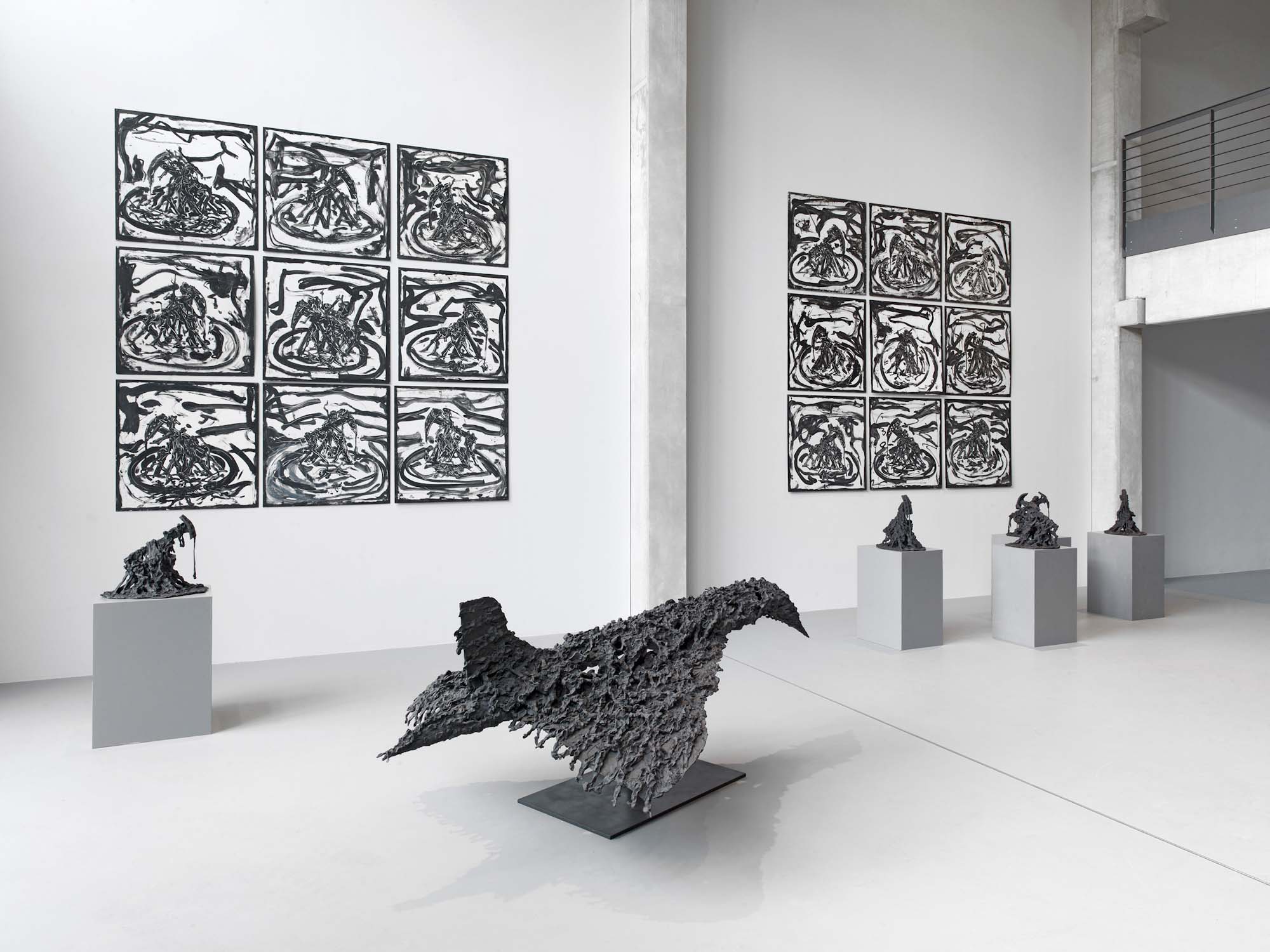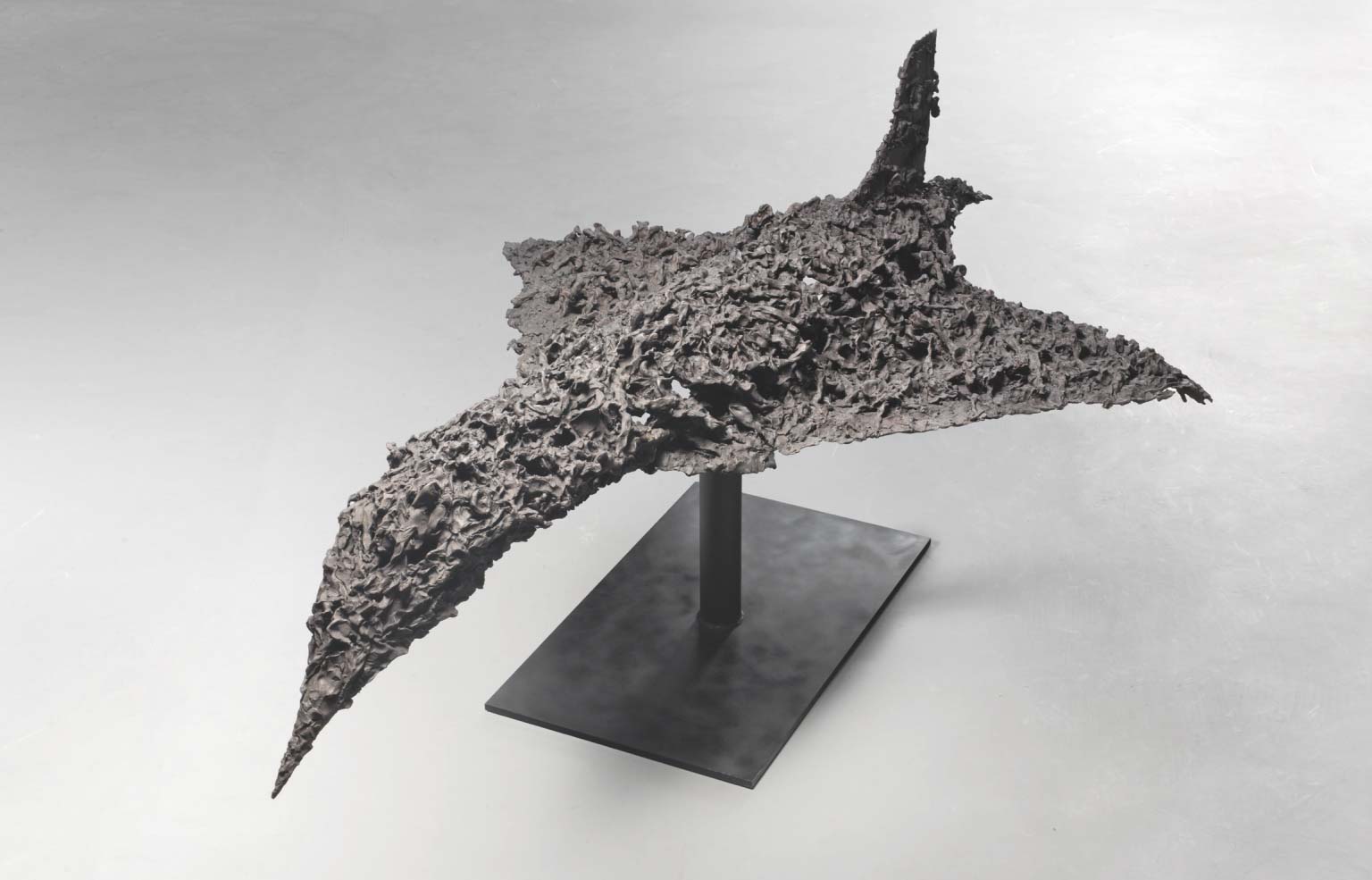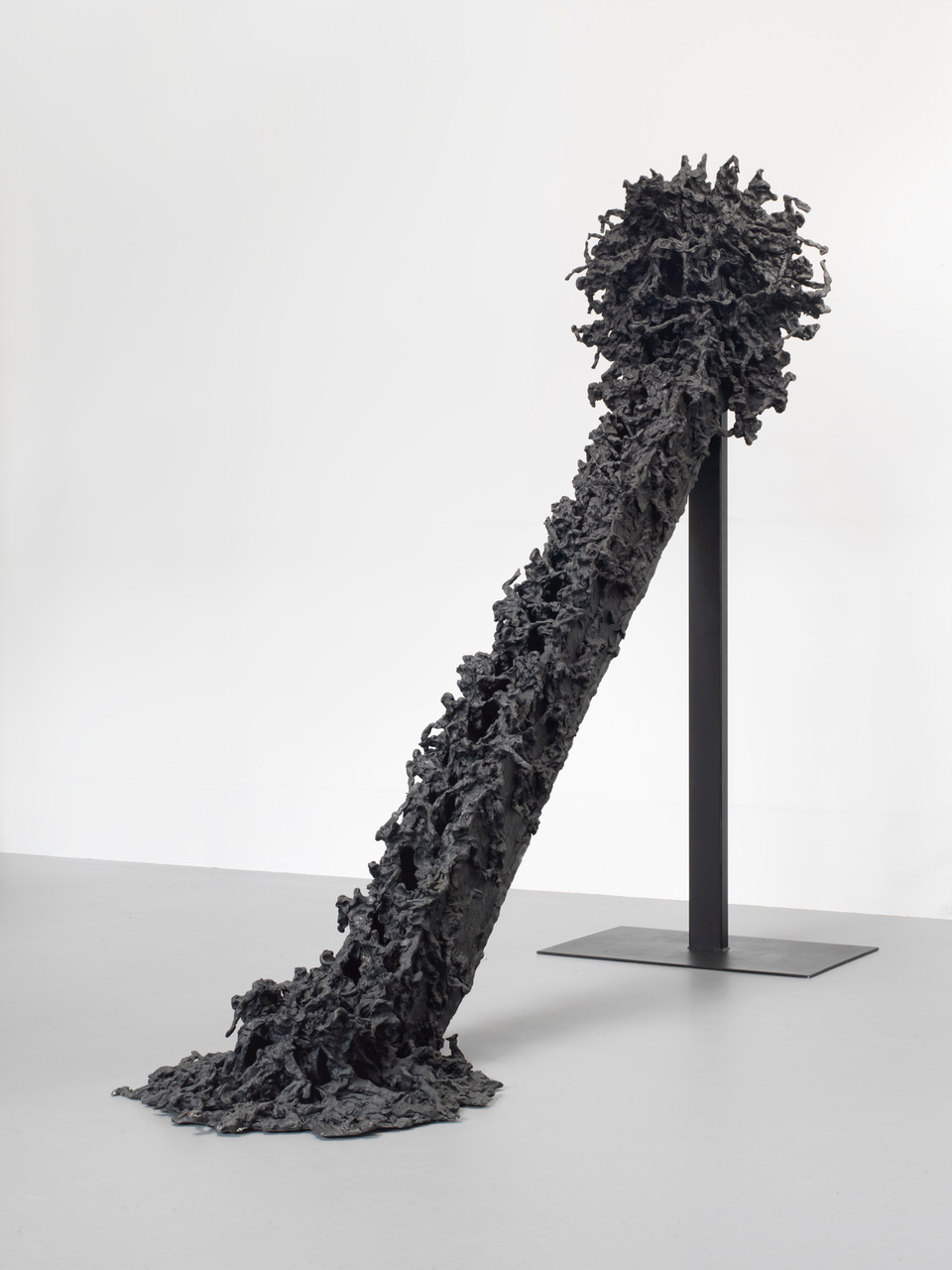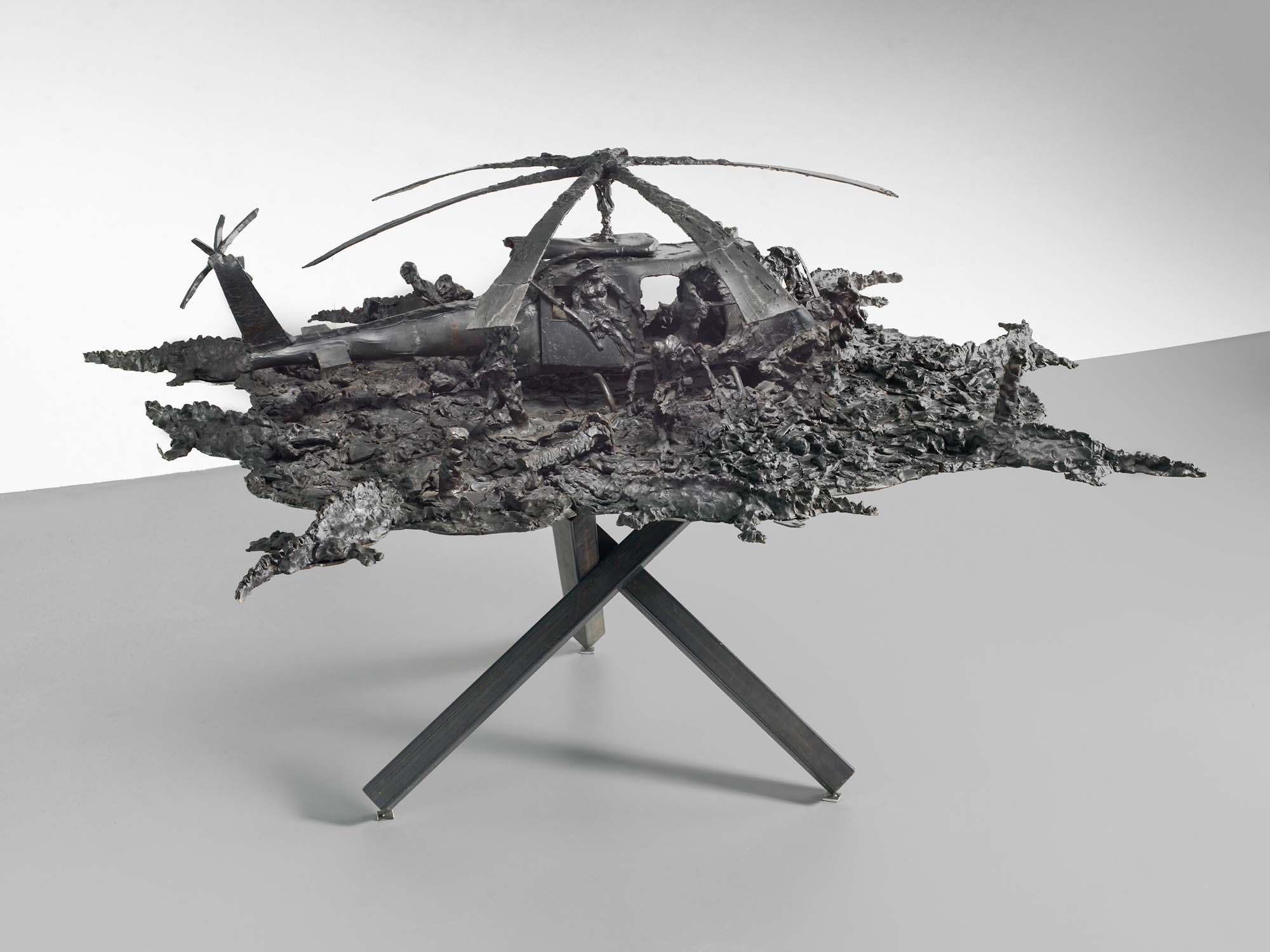
Ricard Larsson Exhibition 2018
Everything is black. The work by Swedish artist Ricard Larsson comes across as a trial without charge and without sentence – but not without humour.
It is the suffering and destruction, which humanity is capable of causing on an unprecedented scale, thanks to its technology, that is on trial here. The grotesqueness and obscenity of these machineries are also reflected suggestively in Larsson’s whirring, unsettling world of shapes. “Look what they are doing!” says Larsson, with a mixture of amusement and dismay and with regard to the crowds of human figures that populate his sculptures. And they are doing a great deal: they are jumping out of burning houses, crawling like ants across overcrowded trains and escalators, tormenting and destroying each other, they are desperate.
The piece titled Island stands out in particular in this respect, an explosion cloud or mushroom cloud which, like all of Larsson’s pieces, carries multi-layered references to the catastrophes of our time: the Gaza war, Fukushima and the French nuclear tests in the Pacific Ocean. As if in contrast to this, however, a different image seems to be pushing its way through the intertwined, seeping and organic shapes, namely that of a tropical rainforest tree. Who is this man, who indulges in this extraordinary fusion of nature and technology, of life and death?
Ricard Larsson was born in 1953 in Stockholm and studied painting and sculpture at the academy of arts. He lived and worked in his workshop near Florence for many years, before he and his wife moved to Berlin, where he moved into his Uferhallen art studio. There he has been dedicated to the development of his art for 20 years now and has created his own domain in doing so. Larsson gushes that it is perfect, referring to his working space, and points out the light which is coming in through the ceiling windows of the hall-like studio room and falling on the teeming crowd made of black wax. Dark green plants and a couple of cats add a bit of friendly liveliness and, strangely enough, blend in perfectly with the catastrophic events.
The rhythm of Larsson’s work in this exceptional place is set by his materials, most notably wax. He has about five minutes’ time to give the material its shape before it solidifies. If you look closer, you can see the fingerprint that Larsson quite literally leaves in his sculptures. The traces of pressing and kneading make the creative intuition that guides Larsson’s work transparent to the observer. In contrast, the time it takes to complete one of his pieces obeys different laws. Sometimes it takes merely hours, sometimes years, before the final form is found.
The last step takes place at the Noack fine art foundry, where the sculptures are transformed into bronze with the help of foundry sand. If you ask Ricard Larsson about the motivation that has driven him to sculptural works, his answers turn out to be much less alarmist than one would expect in view of his catastrophic themes. “It helps to be in this,” he says, and by “this” he means nothing less than this, our world, and the human existence within. Some sort of consolation, then? Certainly not just that, as he definitely makes a point of being obnoxious and shares his deep malaise with regard to the state of the world with the observer, although he does this without pointing fingers or behaving like a moral authority. Perhaps this attitude also explains the organic creatureliness that Larsson bestows on his technical motifs. From here it’s easy to jump to the pessimistic conclusion that the dark side of our civilisation might be part of nature, or at least part of our nature. In any case, the multidimensional nature of the associations found in Larsson‘s works leaves a lot of room for speculation – as does the influence of other artists on his works, for that matter. If you ask him about it, however, he just smiles and waves the idea aside, saying “No, no. It’s all my fault.”
Text: Viktor Gallandi
"It’s all my fault”
The black human comedy of Ricard Larsson
Everything is black. The work by Swedish artist Ricard Larsson comes across as a trial without charge and without sentence – but not without humour. It is the suffering and destruction, which humanity is capable of causing on an unprecedented scale, thanks to its technology, that is on trial here. The grotesqueness and obscenity of these machineries are also reflected suggestively in Larsson’s whirring, unsettling world of shapes.
“Look what they are doing!” says Larsson, with a mixture of amusement and dismay and with regard to the crowds of human figures that populate his sculptures. And they are doing a great deal: they are jumping out of burning houses, crawling like ants across overcrowded trains and escalators, tormenting and destroying each other, they are desperate. The piece titled Island stands out in particular in this respect, an explosion cloud or mushroom cloud which, like all of Larsson’s pieces, carries multi-layered references to the catastrophes of our time: the Gaza war, Fukushima and the French nuclear tests in the Pacific Ocean. As if in contrast to this, however, a different image seems to be pushing its way through the intertwined, seeping and organic shapes, namely that of a tropical rainforest tree. Who is this man, who indulges in this extraordinary fusion of nature and technology, of life and death?
Ricard Larsson was born in 1953 in Stockholm and studied painting and sculpture at the academy of arts. He lived and worked in his workshop near Florence for many years, before he and his wife moved to Berlin, where he moved into his Uferhallen art studio. There he has been dedicated to the development of his art for 20 years now and has created his own domain in doing so. Larsson gushes that it is perfect, referring to his working space, and points out the light which is coming in through the ceiling windows of the hall-like studio room and falling on the teeming crowd made of black wax. Dark green plants and a couple of cats add a bit of friendly liveliness and, strangely enough, blend in perfectly with the catastrophic events.
The rhythm of Larsson’s work in this exceptional place is set by his materials, most notably wax. He has about five minutes’ time to give the material its shape before it solidifies. If you look closer, you can see the fingerprint that Larsson quite literally leaves in his sculptures. The traces of pressing and kneading make the creative intuition that guides Larsson’s work transparent to the observer.
In contrast, the time it takes to complete one of his pieces obeys different laws. Sometimes it takes merely hours, sometimes years, before the final form is found. The last step takes place at the Noack fine art foundry, where the sculptures are transformed into bronze with the help of foundry sand.
If you ask Ricard Larsson about the motivation that has driven him to sculptural works, his answers turn out to be much less alarmist than one would expect in view of his catastrophic themes. “It helps to be in this,” he says, and by “this” he means nothing less than this, our world, and the human existence within. Some sort of consolation, then? Certainly not just that, as he definitely makes a point of being obnoxious and shares his deep malaise with regard to the state of the world with the observer, although he does this without pointing fingers or behaving like a moral authority.
Perhaps this attitude also explains the organic creatureliness that Larsson bestows on his technical motifs. From here it’s easy to jump to the pessimistic conclusion that the dark side of our civilisation might be part of nature, or at least part of our nature. In any case, the multidimensional nature of the associations found in Larsson‘s works leaves a lot of room for speculation – as does the influence of other artists on his works, for that matter. If you ask him about it, however, he just smiles and waves the idea aside, saying “No, no. It’s all my fault.”



